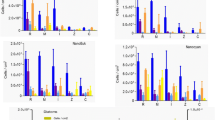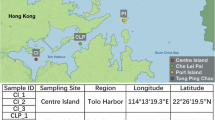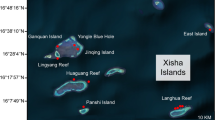Abstract
Biofilms are a significant source of marine biofouling. Marine biofilm communities are established when microorganisms adhere to immersed surfaces. Despite the microbe-inhibiting effect of zinc surfaces, microbes can still attach to the surface and form biofilms. However, the diversity of biofilm-forming microbes that can attach to zinc surfaces and their common functional features remain elusive. Here, by analyzing 9,000,000 16S rRNA gene amplicon sequences and 270 Gb of metagenomic data, we comprehensively explored the taxa and functions related to biofilm formation in subtidal zones of the Red Sea. A clear difference was observed between the biofilm and adjacent seawater microbial communities in terms of the taxonomic structure at phylum and genus levels, and a huge number of genera were only present in the biofilms. Saturated alpha-diversity curves suggested the existence of more than 14,000 operational taxonomic units in one biofilm sample, which is much higher than previous estimates. Remarkably, the biofilms contained abundant and diverse transposase genes, which were localized along microbial chromosomal segments and co-existed with genes related to metal ion transport and resistance. Genomic analyses of two cyanobacterial strains that were abundant in the biofilms revealed a variety of metal ion transporters and transposases. Our analyses revealed the high diversity of biofilm-forming microbes that can attach to zinc surfaces and the ubiquitous role of transposase genes in microbial adaptation to toxic metal surfaces.






Similar content being viewed by others
References
Flemming HC (2002) Biofouling in water systems—cases, causes and countermeasures. Appl Microbiol Biotechnol 59:629–640. https://doi.org/10.1007/s00253-002-1066-9
Douterelo I, Jackson M, Solomon C, Boxall J (2016) Spatial and temporal analogies in microbial communities in natural drinking water biofilms. Sci Total Environ 581:277–288. https://doi.org/10.1016/j.scitotenv.2016.12.118
Stüken A, Haverkamp TH, Dirven HA, Gilfillan GD, Leithaug M, Lund V (2018) Microbial community composition of tap water and biofilms treated with or without copper–silver ionization. Environ Sci Technol 52:3354–3364. https://doi.org/10.1021/acs.est.7b05963
Beech IB, Sunner J (2014) Biocorrosion: towards understanding interactions between biofilms and metals. Curr Opin Biotechnol 15:181–186. https://doi.org/10.1016/j.copbio.2004.05.001
Yebra DM, Kiil S, Dam-Johansen K (2004) Antifouling technology-past, present and future steps towards efficient and environmentally friendly antifouling coatings. Prog Org Coat 50:75–104. https://doi.org/10.1016/j.porgcoat.2003.06.001
Garrett TR, Bhakoo M, Zhang ZB (2008) Bacterial adhesion and biofilms on surfaces. Prog Nat Sci 18:1049–1056. https://doi.org/10.1016/j.pnsc.2008.04.001
Bryan PJ, Qian PY, Kreider JL, Chia FS (1997) Induction of larval settlement and metamorphosis by pharmacological and conspecific associated compounds in the serpulid polychaete Hydroides elegans. Mar Ecol Prog Ser 146:81–90. https://doi.org/10.3354/meps1460814
Chung HC, Lee OO, Huang YL, Mok SY, Kolter R, Qian PY (2010) Bacterial community succession and chemical profiles of subtidal biofilms in relation to larval settlement of the polychaete Hydroides elegans. ISME J 4:817–828. https://doi.org/10.1038/ismej.2009.157
Zhang W, Wang Y, Tian RM, Bougouffa S, Yang B, Cao HL, Zhang G, Wong YH, Xu W, Batang Z, Al-Suwailem A, Zhang XX, Qian PY (2010) Species sorting during biofilm assembly by artificial substrates deployed in a cold seep system. Sci Rep 4:6647. https://doi.org/10.1038/srep06647
Bellou N, Papathanassiou E, Dobretsov S, Lykousis V, Colijn F (2012) The effect of substratum type, orientation and depth on the development of bacterial deep-sea. Biofouling 28:199–213. https://doi.org/10.1080/08927014.2012.662675
Meier A, Tsaloglou NM, Mowlem MC, Keevil CW, Connelly DP (2013) Analysis of hyper-baric biofilms on engineering surfaces formed in the Deep Sea. Biofouling 29:1029–1042. https://doi.org/10.1080/08927014.2013.824967
Lesaulnier CC, Herbold CW, Pelikan C, Berry D, Gérard C, Le Coz X, Gagnot S, Niggemann J, Dittmar T, Singer GA, Loy A (2017) Bottled aqua incognita: microbiota assembly and dissolved organic matter diversity in natural mineral waters. Microbiome 5:126. https://doi.org/10.1186/s40168-017-0344-9
Mayer-Pinto M, Coleman RA, Underwood AJ, Tolhurst TJ (2011) Effects of zinc on microalgal biofilms in intertidal and subtidal habitats. Biofouling 27:721–727. https://doi.org/10.1080/08927014.2011.600448
Wu C, Labrie J, Tremblay YDN, Haine D, Mourez M, Jacques M (2013) Zinc as an agent for the prevention of biofilm formation by pathogenic bacteria. J Appl Microbiol 115:30–40. https://doi.org/10.1111/jam.12197
Harrison JJ, Ceri H, Turner RJ (2007) Multimetal resistance and tolerance in microbial biofilms. Nat Rev Microbiol 5:928–938. https://doi.org/10.1038/nrmicro1774
Harrison JJ, Turner RJ, Ceri H (2005) Persister cells, the biofilm matrix and tolerance to metal cations in biofilm and planktonic Pseudomonas aeruginosa. Environ Microbiol 7:981–994. https://doi.org/10.1111/j.1462-2920.2005.00777.x
Burton NC, Grinshpun SA, Reponen T (2006) Physical collection efficiency of filter materials for bacteria and viruses. Ann Occup Hyg 51:143–151. https://doi.org/10.1093/annhyg/mel073
Thijs S, Op De Beeck M, Beckers B, Truyens S, Stevens V, Van Hamme JD, Weyens N, Vangronsveld J (2017) Comparative evaluation of four bacteria-specific primer pairs for 16S rRNA gene surveys. Front Microbiol 8:494. https://doi.org/10.3389/fmicb.2017.00494
Caporaso JG, Kuczynski J, Stombaugh J, Bittinger K, Bushman FD, Costello EK, Fierer N, Peña AG, Goodrich JK, Gordon JI, Huttley GA, Kelley ST, Knights D, Koenig JE, Ley RE, Lozupone CA, McDonald D, Muegge BD, Pirrung M, Reeder J, Sevinsky JR, Turnbaugh PJ, Walters WA, Widmann J, Yatsunenko T, Zaneveld J, Knight R (2010) QIIME allows analysis of high-throughput community sequencing data. Nat Methods 7:335–336. https://doi.org/10.1038/nmeth.f.303
Edgar RC (2010) Search and clustering orders of magnitude faster than BLAST. Bioinformatics 26:2460–2461. https://doi.org/10.1093/bioinformatics/btq461
Patel RK, Jain M (2012) NGS QC toolkit: a toolkit for quality control of next generation sequencing data. PLoS One 7:e30619. https://doi.org/10.1371/journal.pone.0030619
Hammer Ř, Harper DAT, Ryan PD (2001) PAST: paleontological statistics software package for education and data analysis. Palaeontol Electron 4:9
Li D, Liu CM, Luo R, Sadakane K, Lam TW (2015) MEGAHIT: an ultra-fast single-node solution for large and complex metagenomics assembly via succinct de Bruijn graph. Bioinformatics 31:1674–1676. https://doi.org/10.1093/bioinformatics/btv033
Hyatt D, Chen GL, Locascio PF, Land ML, Larimer FW, Hauser LJ (2010) Prodigal: prokaryotic gene recognition and translation initiation site identification. BMC Bioinformatics 11:119. https://doi.org/10.1186/1471-2105-11-119
Kanehisa M, Sato Y, Kawashima M, Furumichi M, Tanabe M (2016) KEGG as a reference resource for gene and protein annotation. Nucleic Acids Res 44:457–462. https://doi.org/10.1093/nar/gkv1070
Langmead B, Salzberg SL (2012) Fast gapped-read alignment with bowtie 2. Nat Methods 9:357–359. https://doi.org/10.1038/nmeth.1923
Sammut SJ, Finn RD, Bateman A (2008) Pfam 10 years on: 10000 families and still growing. Brief Bioinform 9:210–219. https://doi.org/10.1093/bib/bbn010
Freilich S, Zarecki R, Eilam O, Segal ES, Henry CS, Kupiec M, Gophna U, Sharan R, Ruppin E (2011) Competitive and cooperative metabolic interactions in bacterial communities. Nat Commun 2:589. https://doi.org/10.1038/ncomms1597
Zhang W, Wang Y, Bougouffa S, Tian R, Cao H, Li Y, Cai L, Wong YH, Zhang G, Zhou G, Zhang X, Bajic VB, Al-Suwailem A, Qian PY (2015) Synchronized dynamics of bacterial niche-specific functions during biofilm development in a cold seep brine pool. Environ Microbiol 7:4089–4104. https://doi.org/10.1111/1462-2920.12978
Wu YW, Simmons BA, Singer SW (2016) MaxBin 2.0: an automated binning algorithm to recover genomes from multiple metagenomic datasets. Bioinformatics 32:605–607. https://doi.org/10.1093/bioinformatics/btv638
Kang DD, Froula J, Egan R, Wang Z (2015) MetaBAT, an efficient tool for accurately reconstructing single genomes from complex microbial communities. Peer J 3:e1165. https://doi.org/10.7717/peerj.1165
Parks DH, Imelfort M, Skennerton CT, Hugenholtz P, Tyson GW (2015) CheckM: assessing the quality of microbial genomes recovered from isolates, single cells, and metagenomes. Genome Res gr-186072. https://doi.org/10.1101/gr.186072.114
Wu M, Scott AJ (2012) Phylogenomic analysis of bacterial and archaeal sequences with AMPHORA2. Bioinformatics 28:1033–1034. https://doi.org/10.1093/bioinformatics/bts079
Tamura K, Stecher G, Peterson D, Filipski A, Kumar S (2013) MEGA6: molecular evolutionary genetics analysis version 6.0. Mol Biol Evol 30:2725–2729. https://doi.org/10.1093/molbev/mst197
Langenheder S, Székely AJ (2011) Species sorting and neutral processes are both important during the initial assembly of bacterial communities. ISME J 5:1086–1094. https://doi.org/10.1038/ismej.2010.207
Ding W, Ma C, Zhang W, Chiang H, Tam C, Xu Y, Zhang G, Qian PY (2018) Anti-biofilm effect of a butenolide/polymer coating and metatranscriptomic analyses. Biofouling 34:111–122. https://doi.org/10.1080/08927014.2017.1409891
Lee OO, Chung HC, Yang J, Wang Y, Dash S, Wang H, Qian PY (2014) Molecular techniques revealed highly diverse microbial communities in natural marine biofilms on polystyrene dishes for invertebrate larval settlement. Microb Ecol 68:81–93. https://doi.org/10.1007/s00248-013-0348-3
Brazelton WJ, Baross JA (2009) Abundant transposases encoded by the metagenome of a hydrothermal chimney biofilm. ISME J 3:1420–1424. https://doi.org/10.1038/ismej.2009.79
Tyson GW, Chapman J, Hugenholtz P, Allen EE, Ram RJ, Richardson PM, Solovyev VV, Rubin EM, Rokhsar DS, Banfield JF (2004) Community structure and metabolism through reconstruction of microbial genomes from the environment. Nature 428:37–43. https://doi.org/10.1038/nature02340
Tetaz TJ, Luke RKJ (1983) Plasmid-controlled resistance to copper in Escherichia coli. J Bacteriol 154:1263–1268
Gupta A, Maynes M, Silver S (1998) Effects of halides on plasmid-mediated silver resistance in Escherichia coli. Appl Environ Microbiol 64:5042–5045
Pal C, Bengtsson-Palme J, Kristiansson E, Larsson DJ (2015) Co-occurrence of resistance genes to antibiotics, biocides and metals reveals novel insights into their co-selection potential. BMC Genomics 16:964. https://doi.org/10.1186/s12864-015-2153-5
Vandecraen J, Monsieurs P, Mergeay M, Leys N, Aertsen A, Van-Houdt R (2016) Zinc-induced transposition of insertion sequence elements contributes to increased adaptability of Cupriavidus metallidurans. Front Microbiol 7:359. https://doi.org/10.1186/s12864-015-2153-5
Vandecraen J, Chandler M, Aertsen A, Van-Houdt R (2017) The impact of insertion sequences on bacterial genome plasticity and adaptability. Crit Rev Microbiol 43:1–22. https://doi.org/10.1080/1040841X.2017.1303661
Sun X, Dennis JJ (2009) A novel insertion sequence derepresses efflux pump expression and preadapts Pseudomonas putida S12 for extreme solvent stress. J Bacteriol 191:6773–6777. https://doi.org/10.1128/JB.00832-09
MacDiarmid CW, Gaither LA, Eide D (2000) Zinc transporters that regulate vacuolar zinc storage in Saccharomyces cerevisiae. EMBO J 19:2845–2855. https://doi.org/10.1093/emboj/19.12.2845
Grass G, Franke S, Taudte N, Nies DH, Kucharski LM (2005) The metal permease ZupT from Escherichia coli is a transporter with a broad substrate spectrum. J Bacteriol 187:1604–1611. https://doi.org/10.1128/JB.187.5.1604-1611.2005
Ting CS, Rocap G, King J, Chisholm SW (2002) Cyanobacterial photosynthesis in the oceans: the origins and significance of divergent light-harvesting strategies. Trends Microbiol 10:134–142. https://doi.org/10.1016/S0966-842X(02)02319-3
Bullerjahn GS, Post AF (2014) Physiology and molecular biology of aquatic cyanobacteria. Front Microbiol 5(359). https://doi.org/10.3389/fmicb.2014.00359
Pessi IS, Pushkareva E, Lara Y, Borderie F, Wilmotte A, Elster J (2018) Marked succession of cyanobacterial communities following glacier retreat in the high Arctic. Microb Ecol:1–12. https://doi.org/10.1007/s00248-018-1203-3
Park BS, Li Z, Kang YH, Shin HH, Joo JH, Han MS (2018) Distinct bloom dynamics of toxic and non-toxic Microcystis (cyanobacteria) subpopulations in Hoedong Reservoir (Korea). Microb Ecol 75:163–173. https://doi.org/10.1007/s00248-017-1030-y
Acknowledgments
This study was supported by a research grant from China Ocean Mineral Resource Research and Development Association (COMRRDA17/Sc01) and an award from the King Abdullah University of Science and Technology to P.Y. Qian. The authors are grateful to Ms. Alice Cheung for English editing.
Author information
Authors and Affiliations
Corresponding author
Ethics declarations
Conflict of Interest
The authors declare that they have no conflict of interest.
Electronic Supplementary Material
ESM 1
(DOCX 2087 kb)
Rights and permissions
About this article
Cite this article
Ding, W., Zhang, W., Alikunhi, N.M. et al. Metagenomic Analysis of Zinc Surface–Associated Marine Biofilms. Microb Ecol 77, 406–416 (2019). https://doi.org/10.1007/s00248-018-01313-3
Received:
Accepted:
Published:
Issue Date:
DOI: https://doi.org/10.1007/s00248-018-01313-3




